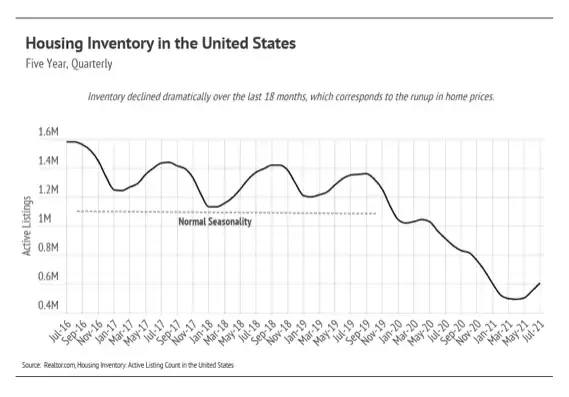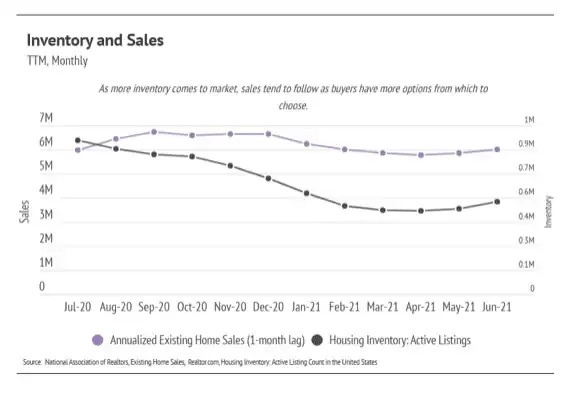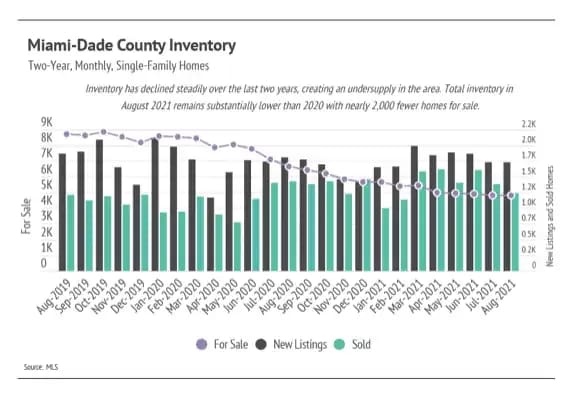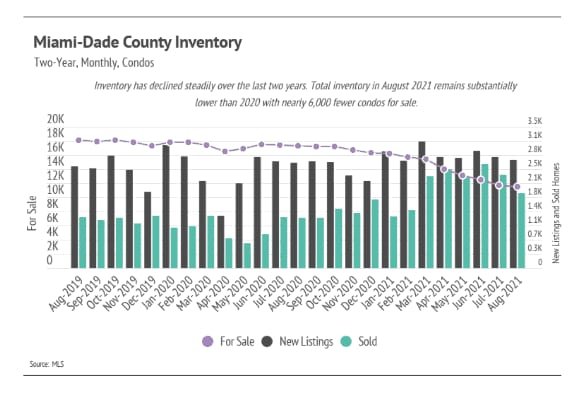
Welcome to our September newsletter, where we’ll explore residential real estate trends in Miami-Dade, Broward, and Orange Counties in Florida, and across the nation. This month, we’ll examine the state of the U.S. housing market now that more supply has come to the market and explore the impact of iBuyers and fin-tech companies’ influences on the housing market.
From 2012 through 2019, the seasonality of the housing market was incredibly stable. For seven years, we consistently saw fewer sales in the winter months and higher sales in the spring and summer months. In 2020, however, we saw a shift. The usual seasonality gave way to super-high demand that remained consistent throughout the year, even after the initial pandemic shock from April to June 2020 faded. Then, in winter 2020 and early spring 2021, inventory decreased to historically low levels. Now we’re far enough into summer to comfortably see pre-2020 seasonal trends return.
Demand for homes has remained quite high, which increased the use of all-cash offers that often serve as differentiators for sellers who receive multiple offers. The National Association of Realtors (NAR) reports that cash sales rose from 16% to 23% year-over-year in July. The increase in cash offers often pushes out first-time homebuyers who don’t have hundreds of thousands (or millions) of dollars on hand. At the same time, we are seeing fin-tech iBuyers (algorithmic instant cash buyers), which is still in its infancy, targeting first-time buyers as a means to stay competitive by making them all-cash buyers. This dynamic could drive demand even higher if fewer buyers are priced out of the market.
As we navigate this period of high buyer demand and low supply, we remain committed to providing you with the most current market information so you feel supported and informed in your buying and selling decisions. In this month’s newsletter, we cover the following:
- Key Topics and Trends in September: Home sales increased as seasonal inventory trends revert to more historical norms (that is, as more homes are coming to market in the summer). The already-high demand for homes could rise even higher as fin-tech companies help first-time buyers remain in the market.
- September Housing Market Updates for selected Florida counties: Single-family homes are massively undersupplied relative to demand, causing prices to appreciate further. Condo prices remain stable.
Key Topics and Trends in September
Housing inventory started falling steadily in April 2020 in response to the pandemic, and the steady seasonal norms in supply vanished completely. As you can see from the chart below, we are starting to see a hint of seasonality return with the inventory increase over the summer months, albeit at a much lower level. As inventory crossed below the 600,000 level, sales began to slow; there simply weren’t enough homes to meet buyer demand, which created a hyper-competitive market for buyers. We are pleased to see inventory increase to alleviate some of the extreme demand.

The chart below, which illustrates sales over the last 12 months, reveals that sales often trend with inventory, but with a one-month lag. In other words, more sales are recorded when more inventory comes online during the previous month. For most of 2021, even though we were on pace to have a record number of home sales, the rate of sales was slowing. That deceleration, however, has reversed as more homes have come to the market.
The last year has taught us that uncertainty around the pandemic has positively correlated to home sales. People are spending more time at home, and the Federal Reserve is expected to keep mortgage rates low. As shown in the chart below, we’re currently hovering at historically low mortgage rates, which will likely remain for the rest of the year. Low-rate financing incentivizes buying, which has been one reason for the high demand over the last 18 months.
The housing market’s competitiveness has increased the number of all-cash purchases to the highest level we’ve seen in the last 10 years. In July 2021, NAR reported that 23% of home sales were cash purchases, which marks a 7% increase from 2020. The competitive nature of the current market has priced out many first-time homebuyers, but we could see that shift with the emergence of iBuyers, who can quickly purchase a home in cash. The speed with which buyers need to secure financing is often part of the problem for first-time buyers. iBuyers can offer the speed and financing necessary for a competitive offer.
With such low supply and high demand for homes, we could see the market become even more competitive if fewer buyers are priced out of the market. Currently, a low percentage of sales involve iBuyers; however, if iBuyers become more common, supply could trend even lower than it already is.
While the market remains competitive for buyers, conditions are making it an exceptional time for homeowners to sell. Lower inventory means sellers will receive multiple offers with fewer concessions. Because sellers are often selling one home and buying another, it’s essential that sellers work with the right agent to ensure that the transition goes smoothly.
Single-Family Home Inventory
After a two-year decline in inventory, more new listings are coming to market, which is common for the summer season. To fully understand the current inventory, we must look at it in the context of last year. In 2020, fewer people wanted to leave Florida and more people wanted to move to the area, increasing the population and driving inventory down to record low levels. New listings, therefore, improve the current market conditions. However, new inventory has not been able to meet demand, causing inventory to decline further. In August 2021, the selected counties had far fewer homes for sale than the year before. The sustained low inventory will likely cause prices to appreciate throughout 2021.
Condo Inventory
Condo inventory has been experiencing a gentler trend down over the last two years. We are seeing more condos come to market, which are immediately offset by sales. The demand is there, but not to the extent of single-family homes.
Single-family homes spent less time on the market in August 2021 than they did last year. As we will see, the pace of sales has contributed to the low Months of Supply Inventory (MSI) over the past several months.
In summary, the high demand and low supply in the selected Florida counties have driven home prices up over the last year, but the huge price appreciation is slowing. Inventory will likely remain historically low this year with the sustained high demand in the area. Overall, the housing market has shown its value through the pandemic and remains one of the most valuable asset classes. The data show that housing has remained consistently strong throughout this period.
We expect the number of new listings will continue to increase in the remaining summer months. The current market conditions, however, can withstand a high number of new listings, and more sellers may also enter the market to capitalize on the high buyer demand. As we navigate the summer season, we expect the high demand to continue, and new houses on the market to sell quickly.
As always, we remain committed to helping our clients achieve their current and future real estate goals. Our team of experienced professionals are happy to discuss the information we’ve shared in this newsletter. We welcome you to contact us with any questions about the current market or to request an evaluation of your home or condo.














